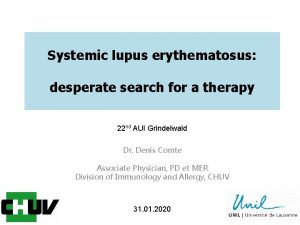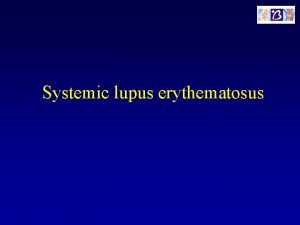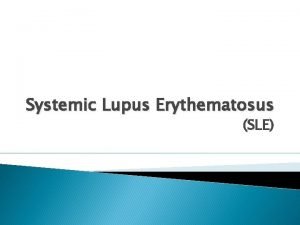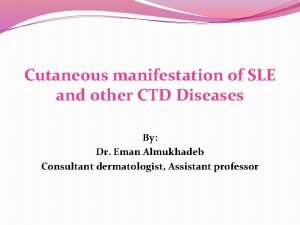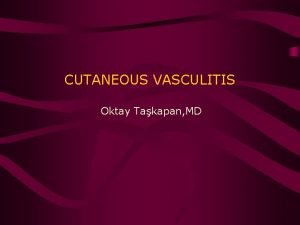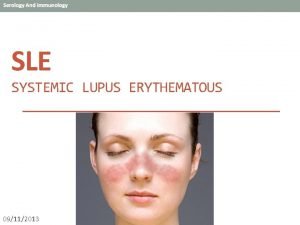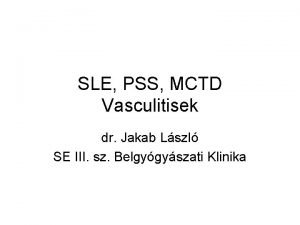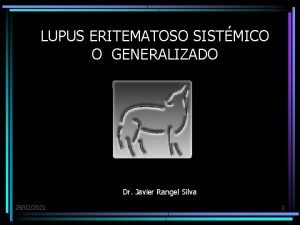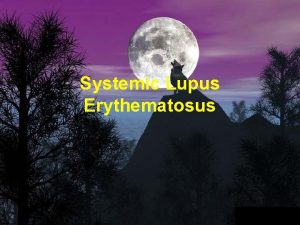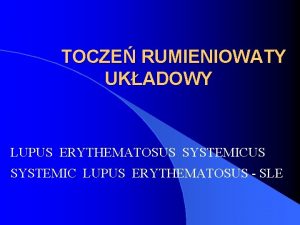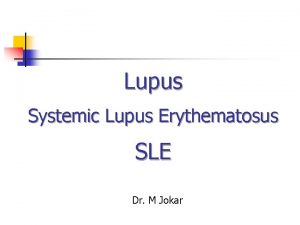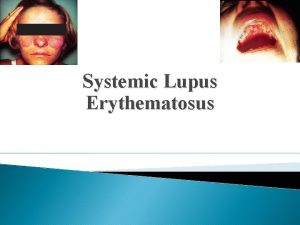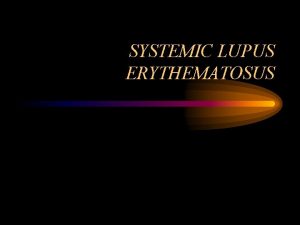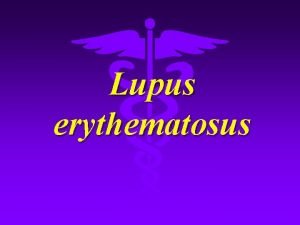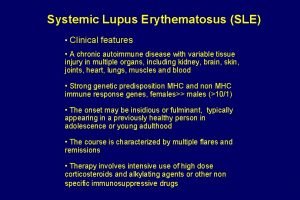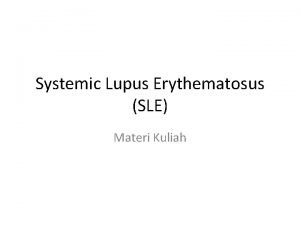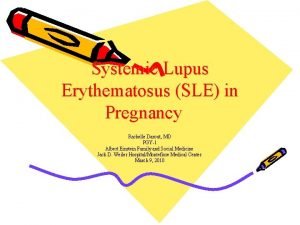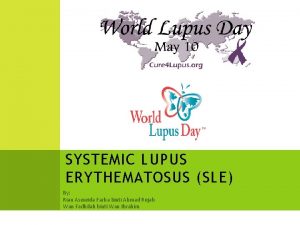Systemic Lupus Erythematosus Systemic Lupus Erythematosus SLE n


















- Slides: 18

Systemic Lupus Erythematosus

Systemic Lupus Erythematosus (SLE) n Multisystemic inflammatory chronic disease characterized by inflammation of blood vessels and connective tissues, caused by presence of activated helper T – cells that induce a B cell response, resulting in the secretion of pathogenic autoantibodies and formation of immune complexes. OR n SLE is an autoimmune disease, which means that the body's natural defense system (immune system) attacks its own tissues instead of attacking foreign substances like bacteria and viruses.

Etiology: n Cause unknown q Many factors play a role in immune dysregulation n n Genetic (HLA types B 8, DR 2, DR 3) Hormones ( attacks during menses, pregnancy due to Estrogen ) Environmental factors (ultra voilet ray viruses e. g; EBV ) Drugs induced lupus (anticonvulsants, salfonamides, penicillamine)

Non specific response to an antigenic stimulus/ loss of tolerance to self antigen Polyclonal activation of B cells Immunoglobulins & autoantibodies Form circulating and tissue bound immune complexes Complement fixation & recruitment (screening) of inflammatory cells TISSUE INJURY

• Fibrinoid deposits found on blood vessel walls and affected organs. Rheumatoid nodules and granulomas maybe present n Auto antibodies are formed against DNA & other nuclear antigens, ribosomes, platelets, coagulation factors, immunoglobulins, erythrocytes, leukocytes

Epidemiology n n Incidence unknown Vary depending on ethnicity and location 4250/100, 000 population n Age: Unusual before 8 yrs (have been diagnosed even in first yr of life) n Sex: Female predominance 1: 4 before puberty to 1: 8 after puberty

Diagnosis n Criteria for diagnosis require presence of 4 of 11 criteria serially or simultaneously , during any interval of observation.

n American College of Rheumatology Classification Criteria for Systemic Lupus Erythematosus n 1. Malar rash: fixed erythema, flat or raised, over the malar eminences, tending to spare the nasolabial folds Discoid rash n 2. Discoid rash: erythematous, raised patches with adherent keratotic scaling and follicular plugging; possibly atrophic scarring in older lesions

Cont … n 3. Photosensitivity: skin rash as a result of unusual reaction to sunlight, as determined by patient history or physician observation n 4. Oral ulcers: oral or nasopharyngeal ulceration, usually painless, observed by physician n 5. Arthritis: non – erosive arthritis involving two or more peripheral joints, characterized by swelling, tenderness, or effusion

n 6. Serositis: - pleuritis, by convincing history of pleuritic pain, rub heard by physician, or evidence of pleural effusion; or --- pericarditis documented by electrocardiography, rub heard by physician, or evidence of pericardial effusion n 7. Renal disorder: ---- persistent proteinuria, > 500 mg per 24 hours (0. 5 g per day) or > 3+ if quantitation is not performed; or ---- cellular casts (may be red blood cell, hemoglobin, granular, tubular, or mixed cellular casts) n 8. Neurologic disorder: ---- seizures or psychosis occurring in the absence of offending drugs or known metabolic derangement (e. g. , uremia, ketoacidosis, electrolyte imbalance)

n 9. Hematologic disorder: n n hemolytic anemia with reticulocytosis; or leukopenia, < 4, 000 per mm 3 on two or more occasions; or lymphopenia, < 1, 500 per mm 3 on two or more occasions; or thrombocytopenia, < 100 x 103 per mm 3 in the absence of offending drugs

n n n 10. Immunologic disorder: antibody to double-stranded DNA antigen (anti-ds. DNA) in abnormal titer; or presence of antibody to Sm nuclear antigen (anti. Smith); or positive finding of antiphospholipid antibody based on : 1. an abnormal serum level of Ig. G or Ig. M anticardiolipin antibodies, 2. a positive test result for lupus anticoagulant using a standard method, or 3. a false-positive serologic test for syphilis that is known to be positive for at least 6 months and is confirmed by negative Treponema pallidum immobilization or fluorescent treponemal antibody absorption test 11. Antinuclear antibodies: an abnormal antinuclear antibody titer by immunofluorescence or equivalent assay at any time and in the absence of drugs known to be associated with drug-induced lupus

Serology q q Almost all patient with SLE have demonstrable ANAs Anti – double – stranded DNA antibodies is highly specific Anti – histone antibodies (drug induced lupus erythematous) Anti – Sm antibodies (CNS lupus)

Treatment n Depend on affected target organ and disease severity q q q Glucocorticoids form the mainstay of therapy. Prednisolone is usually started in doses of 1 – 2 mg/kg/day and then gradually tapered according to disease activity. NSAIDs for arthralgia and arthritis Sunscreen lotions 3 – 4 times/days.

Cont… q q q Life – threatening complications (nephritis, myocarditis, encephalopathy): ------ use of I. V of methyl prednisolone or dexamethasone for 3 – 5 days, followed by oral prednisolone. Severe lupus nephritis ------ I. V cyclophosphamide IVIG (nephritis, vasculitis and acute thrombocytopenia) Antibiotics

Cont… n n For almost all patients with SLE, low dose prednisolone (2. 5 – 5 mg/kg) has to be continued for many years. After stable, hydroxychloroquine (5 – 6 mg/ kg): for mild manifestations (skin lesions, arthritis arthralgia) and further tapering of steroids. q q Side effects of Steroids include : fluid retention, weight gain, high blood pressure, potassium loss, headache, muscle weakness, puffiness of and hair growth on the face, thinning and easy bruising of the skin, glaucoma, cataracts, peptic ulceration, worsening of diabetes, irregular menses, growth retardation in children, convulsions, and psychic disturbances (depression, euphoria, insomnia, mood swings, personality changes, and even psychotic behavior).

Cont… n n n Minor manifestations respond to NSAIDs, low dose corticosteroids, hydroxychloroquine or methotrexate Major manifestations (immunosuppressive therapy) --- high dose of corticosteroids, azathioprine, methotrexate, cyclosporin and cyclophospamide Mycophenolate mofetil (new drugs) those not responding to cyclophosphamide or azathioprine. q Anticoagulant medications: Thrombosis, antiphospholipid antibodies or lupus anticoagulant

Prognosis n Childhood SLE : 5 yr survival 90% n Major cause of death include q q Infection CNS complications Pulmonary hemorrhage Myocardial infarction
 Case study 87 systemic lupus erythematosus
Case study 87 systemic lupus erythematosus Lupus
Lupus Drug induced sle
Drug induced sle What are the 11 criteria for lupus
What are the 11 criteria for lupus Sle aro ale examples
Sle aro ale examples Ana boyanma paternleri
Ana boyanma paternleri Sle programación
Sle programación Service level expectation
Service level expectation Cause of sle
Cause of sle Calcinosis cutis
Calcinosis cutis Sle vasculitis
Sle vasculitis Asuhan keperawatan lupus
Asuhan keperawatan lupus Lupus eritematoso
Lupus eritematoso Konsep keperawatan anak sakit
Konsep keperawatan anak sakit Sle vasculitis
Sle vasculitis Anemia sle
Anemia sle Dr jakab lászló immunológus
Dr jakab lászló immunológus Complemento lupus
Complemento lupus Lupus eritematoso sistémico
Lupus eritematoso sistémico

